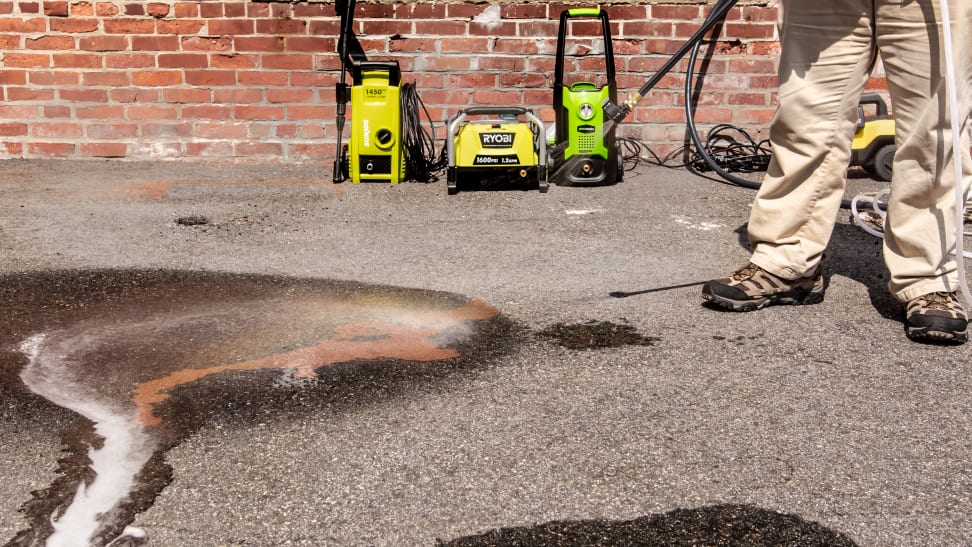 — Recommendations are independently chosen by Reviewed’s editors. Purchases you make through our links may earn us a commission.
— Recommendations are independently chosen by Reviewed’s editors. Purchases you make through our links may earn us a commission.We’ve all seen the videos online. A person stands in front of a dingy patch of asphalt, takes a wand, and sprays down the surface with an abrasive blast of water. What was once an unsightly mess is now as good as new. It’s modern-day magic.
All over the internet, there are groups of people who are pressure washer fanatics, calling those before-and-after videos visual ASMR. Pressure washers may seem like toys, but in reality, they’re incredibly valuable tools to any homeowner. Instead of having to sand, scrub, and scrape for hours, a cleaning job can take minutes with a pressure washer.
We tested a variety of washers, ranging from lightweight, portable devices perfect for smaller projects to heavy, sturdy beasts that would catch the eye of trained professionals. Our favorite, the Karcher K4 (available at Amazon for $239.99) was a crossover, ideal for homeowners and professionals alike. And if you’re looking to save some money, you can’t go wrong with the impressively powerful Wholesun 3000PSI (available at Amazon) pressure washer.
Here are the best pressure washers we tested, ranked in order:
- Karcher K4
- Wholesun 3000PSI
- Dewalt DWPW2400
- Ryobi RY142300
- Sun Joe SPX3000
- Karcher K3 Follow Me
- Sun Joe SPX1000
- Ryobi RY141612
- Suncoo 3000PSI
- Worx WG629
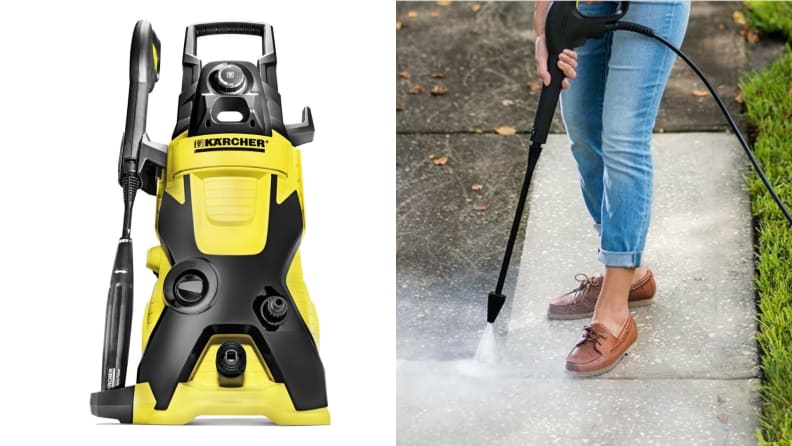

The Karcher K4 is the best pressure washer we've tested.
Sure, this 27-pound, German-designed washer performed extremely well at cleaning away dirt, sand, and paint with 1,900 PSI and 1.5 GPM, but believe it or not, it’s the small design features that made it stand out from the rest.
We found that when others required five or six spray nozzle attachments, the Karcher really only needed the two included in the box. The adjustable default spray wand does a fine job at soap cleaning on the low side, and if you want a higher intensity, just turn the head to the right to engage the “DirtBlaster,” an impressively potent pressure wash.
For an even more intense wash, the “DirtBlaster” turbo nozzle easily clicks into the spray gun. We found that the default attachment did a great job at clearing off mud and gutter debris, while the turbo nozzle excelled at stripping paint when others couldn’t meet the task.
But where the K4 really shines is with the little stuff. The feature we loved the most was its simplest: the garden hose hook-up. To attach the hose, just unclip the adapter from the machine, screw it onto the hose, and snap it back onto the intake. It’s comically simple, especially considering other washers seemingly required extra sets of hands to attach a hose, and they still leaked all over the place.
We also loved the soap intake bottle and the dial to adjust how much soap the device sips up. Even after days of testing, there was still soap in the machine, meaning the consumer can save on how much detergent they have to buy.
The common complaint with this washer is that it’s made entirely of plastic, which is something a customer might want to avoid at this price point. But despite that, the Karcher K4 feels sturdy, cleans efficiently, and has enough design features that we think makes it the top pressure washer.
Pros
-
Intuitive design features, like hose hook-up
-
Powerful nozzles are easy to swap out
-
Runs fairly quietly
Cons
-
Hose storage could be improved
-
Made of plastic
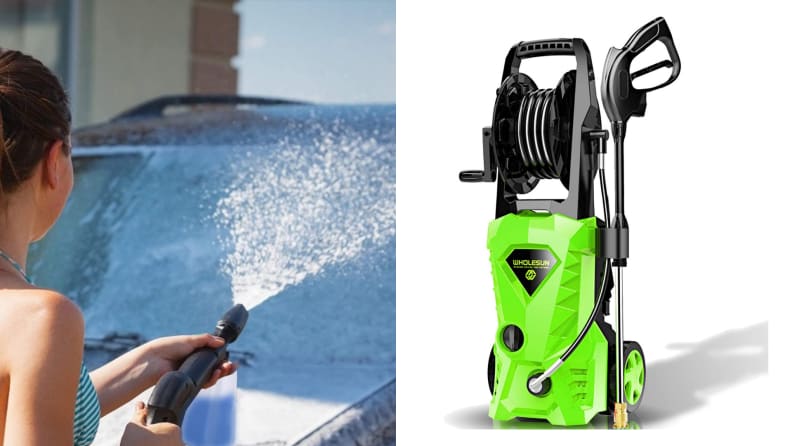

The Wholesun 3000PSI is the best value option for pressure washers.
The first thing you’ll probably notice about the Wholesun 3000PSI pressure washer is how light it is. Standing at a little over 2 ft. tall, this 19-pound machine is a compact little thing. But just wait until you turn it on.
This washer packs a punch with 3,000 pounds of water pressure per square inch, and a 2.4 GPM. That was considerably more than even some of the industrial-style, brand-name washers we tested. The Wholesun cleaned mud and a clogged gutter with considerable ease. Using 15- and 0-degree nozzles, it slowly cleaned away paint from vinyl and aluminum siding, wood, brick, and pavement when others failed to.
But what we really liked about this little green machine was everything that was included in the box. It has four spray nozzles (40-, 25- 15-, and the intensely abrasive 0-degree nozzle), a bottle nozzle for soap cleaning (which it does really well), and a brush head for detailing work.
The wind-up storage reel for the device’s 20-foot hose was a real show-stopper. Being able to wind the hose up, wrap the power cord onto the back, and have a slot for the spray attachments meant this little device can be neatly stored away without taking up too large of a footprint.
Strangely enough, though, those four nozzle heads don’t have any onboard storage, so make sure you don’t lose the plastic bag they came in. We also thought the device itself felt a bit flimsy and cheaply made, but for the price, you can’t beat the sheer power of the Wholesun 3000PSI. All the bonus attachments are just icing on the cake.
Pros
-
Surprisingly powerful
-
Lightweight
-
Thoughtful features, like windup hose storage and bonus attachments
Cons
-
Seems like it could break easily
-
No storage for nozzles
-
Spray wand holster lets tip drag
How We Tested
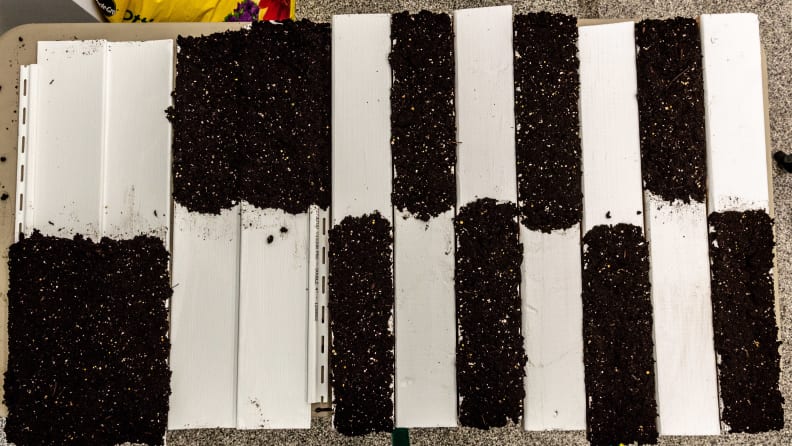
We placed compacted dirt on wood, vinyl, and aluminum.
The Tester
Hey there! I’m Nick Bove, and I’m a jack-of-all-trades broadcaster, announcer, and voiceover artist based out of Boston. Along with Jon Chan, the senior lab technician at Reviewed, I performed all the tests in this pressure washers roundup. I built upon Jon’s initial pressure washer testing with half a dozen new models.
The Tests
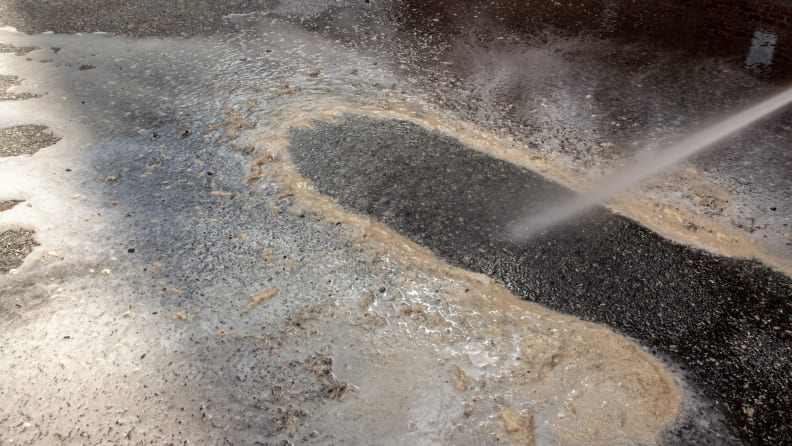
We tested on a variety of surfaces, ranging from asphalt to wood.
I recently moved into a house, and it truly is amazing how many projects pop up when you’re responsible for your own space. As soon as one thing is finished, three more come out of nowhere. That’s where a tool like a pressure washer can help. Instead of spending hours scrubbing the outside of my house, a 2,300 PSI washer with a 25-degree spray tip can do the job in a quarter of the time.
While gas-powered pressure washers are also an option, we tested a number of the top-selling electric pressure washers across the market, ranging from 1,450 to 3,000 PSI. All of them are electric-powered and marketed to homeowners, but we found that smaller machines with a lower intensity did the job just fine.
Look at the box of any pressure washer, and you'll see something about PSI, GMI, or Amps. While all those specs are very interesting, what is really important is if the pressure washer can clean and if it is easy to use.
For cleaning, we painted vinyl, wood, aluminum, brick, and asphalt and then, covered each with half an inch of compacted dirt. We blasted each of these surfaces with the pressure washers on various settings and gauged how easily we could get rid of the dirt and not damage the paint. After the tough but gentle approach, we went full bore and tried to strip exterior and spray paint off of all the surfaces.
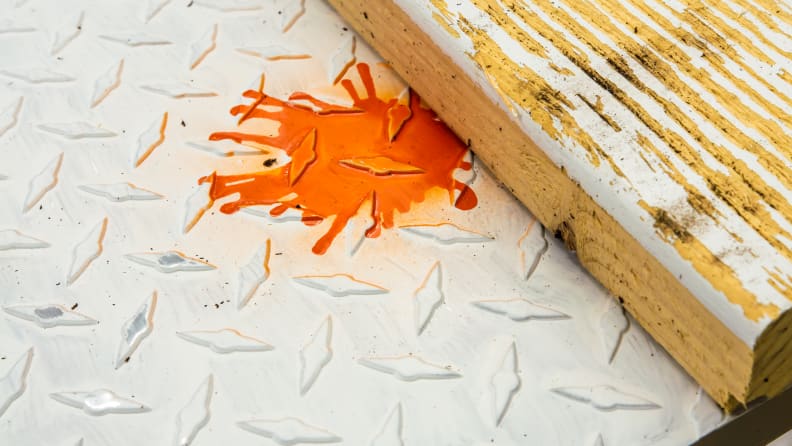
Stripping paint is a tough job, even for a pressure washer.
The pressure washers that proved exceptional were presented one last challenge: a clogged gutter. This gutter wasn't clogged with leaves but a man-made pseudo-sandstone created by mixing sand and flour. We tested to see if it could blast through without damaging the gutter.
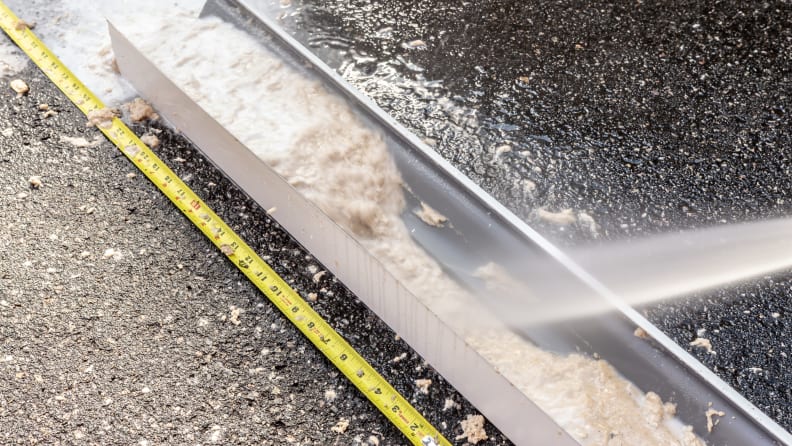
Strong candidates were given the additional test of cleaning a clogged gutter.
We also subjectively tested each device’s soap cleaning feature. We filled each soap intake tank or bottle with a pint of generic pressure washer detergent mixed with water, got a feel for how uniform the soap spray was, and noted how long the suds lasted.
What You Should Know About Pressure Washers
Power Washing vs. Pressure Washing
Pressure washers are not the same as power washers. The major difference between the two is that power washers heat up water to aid in cleaning. Typically, power washers are reserved to remove mold, mildew, and heavy-duty stains like oil.
Pressure Washer Measurements
PSI: Pounds per square inch is the overall amount of power each pressure washer can put out.
GPM: Gallons per minute measures the water flow rate
Induction Motor vs. Universal Motor
Gas engines and electric motors each have their pros and cons. Because we only tested electric pressure waters, we’ll stick to those.
Without getting into the nitty-gritty, induction motors are quieter and last longer, but they are heavier and more expensive. They are also easier to replace because they have a standardized design. They’re typically used for larger units like table saws.
Universal motors tend to be lighter, have higher initial torque, and cost less. That’s why you’re more likely to find them in more handheld devices.
How to Pressure Wash a House
If the exterior of your house is made of hardboard, rock-dash, bottle-dash, or similar material, you should avoid pressure washing your walls. For safety’s sake, you should remember to cover any outdoor outlets, avoid using ladders while operating a pressure washer, and be wary of debris falling off your home or being kicked up off the ground.
We suggest you start with the 25- or 40-degree tip of the pressure washer for cleaning siding. You should start washing. from top to bottom, in order to more efficiently deal with falling grime. When you start your pressure washer, stand about three feet away from your target, and move towards it, as needed. This way, you’ll avoid applying too much pressure and damaging the surface you're trying to clean.
Pressure washers can damage lawns and shrubbery. So when you’re pressure washing walkways and patios, cover your delicate plants with plastic sheeting or drop cloths. You'll need to be careful and avoid outdoor furniture as well, although some cushions may fare OK using one.
What Kind of Hose You Should Use
While pressure washers have motors, a strong and even flow is required for them to work. We did some testing and some research and think the Flexzilla Garden Hose is perfect general usage.
Of all the hoses that we tested, the Flexzilla provided the best balance of sturdiness and flexibility. It comes in a variety of sizes, up to 100 ft. in length, which is more than enough to cover the average driveway.
Detergents for Pressure Washers
We strongly recommend reading the owner’s manual to see what each model recommends. Beyond that, most pressure washer detergents come in the form of concentrates. That means you premix the solution with water before you place it into the unit. This also means you should wear protective gloves while handling the cleaning solution.
There are some guides out there that suggest making a bleach solution for dealing with mold. We would not recommend that. Bleach is pretty toxic and having it splattered everywhere will not do you or your yard any favors.
Renting Pressure Washers
Many hardware stores, like The Home Depot, provide pressure washers to rent. For one-time jobs, it can totally be worth it.
For example, if you’re planning on giving your house a once-over before putting it on the market, renting a pressure washer might be a good idea. However, if you’re settled in and planning on doing some cleaning every spring and summer, owning a pressure washer will pay for itself.
How to Winterize a Pressure Washer
Electric pressure washers are fairly simple to winterize. All you need to do is drain all the hoses and detergent tanks. To drain the hoses, detect them, unroll them, and hold them up—all the water should drain out.
Detergent tanks are also fairly simple. You can clean them out by simply flushing them out with a hose. Just be sure to let them dry out before storage. If you store your pressure washer in the basement, you can place it near a low-powered space heater to prevent any freezing.
If you live in a colder climate, you may also opt to fill the unit with anti-freeze designed for small pumps.
Other Pressure Washers We Tested

This beast of a pressure washer is marketed as a consumer device, but you’ll feel like a professional when you use it. Wheeling it around on its 10-inch pneumatic wheels is a breeze, which is a good thing because it weighs over 45 pounds.
Belying its heft, the Dewalt DWPW2400 runs surprisingly quietly. When blasting away debris, the engine never got that loud, and the jet of water didn’t clang off the testing surfaces that much. Releasing the trigger on the spray away quickly and effectively shuts off the engine entirely.
Its 2,400 PSI and 1.3 GPM was effective at clearing away mud and sand, but we found it was surprisingly slow at clearing away paint from all surfaces. Unlike other pressure washers, no 0-degree spray tip was included, so we conducted most of the tests with the 15-degree nozzle and the turbo nozzle, which wasn’t as effective as we would have liked. It also includes 40- and 25-degree nozzles.
We did enjoy using the soap function, though. The soap tank is extremely easy to load and the suds the machine shot out were plentiful.
Pros
-
Impressive built quality and heft
-
Includes plenty of nozzles
-
Easy-to-use soap function
Cons
-
Took a surprisingly long time to clear away paint
-
Expensive

Another professional-looking pressure washer, the 49-pound Ryobi RY142300 cuts a few too many corners, which is curious because it is one of the more expensive machines in this field.
Whereas the Dewalt’s engine shuts off when the trigger is released, the Ryobi’s engine runs the whole time the machine is turned on. The Dewalt has 10-inch pneumatic wheels; the Ryobi has 12-inch plastic wheels. The Dewalt has five nozzles ranging from soft to abrasive; the Ryobi has a soft soap nozzle, an abrasive 15-degree nozzle, and a super abrasive turbo nozzle.
The Dewalt’s soap tank is easy to load, use, and empty; the Ryobi’s soap tank is dark, hard to load, and nigh impossible to empty. We could go on, but you get the idea.
On the positive side, it was quite effective at clearing away mud, sand, and even paint from all surfaces with the 15-degree and turbo nozzles, 2,300 PSI, and 1.2 GPM. It was even quiet when it was doing it, which was surprising because we found when pressing the trigger, the device has one heck of a recoil. You’ll definitely want to make sure the nozzles are completely attached, otherwise, you’ll have a dangerous projectile weapon.
In short, if we were just testing the Ryobi, we’d recommend it. But knowing there are other options out there with more user-friendly features, we’d advise looking elsewhere, especially for the price tag.
Pros
-
Impressive built quality and heft
-
Includes plenty of nozzles
-
Easy-to-use soap function
Cons
-
Took a surprisingly long time to clear away paint
-
Expensive

The 31-pound Sun Joe SPX3000 was a real contender alongside the Karcher K4, but where the Karcher succeeded at cleaning away material, the Sun Joe came up just short. It quickly cleared mud and sand, but paint was more difficult to get off. Its engine was also a bit on the loud side, which was unexpected because it only outputs a little under 1,500 PSI with 1.76 GPM on regular use.
We really liked how effortless it was to swap out spray tips on this machine. The color-coded nozzles (40-, 25-, 15-, 0-degree, and soap) snap in and out in the blink of an eye and easily store away on the backside of the device. Also included are two soap dispenser bottles, which were simple to load and use (we loved being able to adjust the detergent output with the dispenser dial).
We would like to see some small improvements with this model, like a better hose management system, and an improved garden hose hook-up. Whenever we turned the machine on, it would invariably blast streams of water from where the hose connects on the front, forcing us to lay the washer on its back to get the leverage needed to close the seal.
If Sun Joe could make those small improvements and maybe increase its PSI a little more, the future model of the SPX3000 could surely be named best pressure washer. Unfortunately, that time isn’t right now.
Pros
-
Spray tips are easy to swap in and out
-
Dispenser dial helps limit soap usage
-
Effective at clearing away loose materials
Cons
-
Garden hose hook-up is hard to use
-
Surprisingly loud
-
Hose management system isn’t great
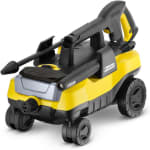
In our initial testing, we really liked this model's versatility. The main nozzle is highly adjustable, going from a regular garden hose's pressure to powerful enough to strip paint from wood.
It also comes with a great rotary nozzle. What sets this model apart from the rest is that it moves on four wheels. With its low center of gravity, it's nigh impossible to tip the 20-pound K3 over.
Great cleaning with 1,800 PSI and 1.3 GPM, sleek design, and included features make the K3 a solid choice. However, we experienced issues with the power supply. We often see this problem when dealing with appliances that are converted from European sources. If it's tough to turn on, then it's tough to use.
Pros
-
Adjustable spray
-
Easy to move
Cons
-
Power supply issues
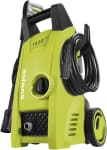

When we first unpacked the 15-pound Sun Joe SPX1000, we didn't have high hopes. The looser feel of some of the parts and the lower 1,450 PSI rating stacked the odds against this electric-powered pressure washer.
That being said, the SPX1000 utilized what it had better than most on this list, and was our best value option in our initial tests. We liked that it included a nozzle that could be adjusted from a high-pressure pencil-sized stream to a 45-degree fan. This allowed us to power wash away dirt gently or strip paint.
Although we should note that we didn't like that all specialized nozzles are sold separately, like the detergent tank.
Pros
-
Very adjustable
-
Easy to use
Cons
-
All attachments sold separately
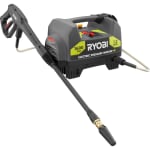

Our previous best pressure washer winner is certainly a solid device, especially for its 16-pound size, but compared to the other devices we tested, it’s lacking in certain features.
For being only a 1,600 PSI washer, it is pleasantly powerful. It cleared mud and sand without much effort, and it actually worked quickly to remove paint from brick and pavement with its turbo nozzle. Like the other Ryobi we tested, it only comes with three spray tips, but with a smaller device like this one, it actually makes more sense to have fewer options.
Unfortunately, that powerful engine is quite loud, probably to make up for its small size. It is also a bit unwieldy to carry around and store since it’s only a little bigger than a car battery, but it has a 20-foot hose, a 35-foot power cord, and a 2-foot-long soap injection hose that somehow have to all get bound up together.
We previously didn’t test the soap function on this washer, so we noticed how obnoxious it was to use this time around. The consumer has to have a bucket to hold the detergent mix, and then when using it, they have to make sure the injection head is fully submerged, otherwise it’ll just suck up air.
When it does pull up soap, it does so rapidly, so users will need to make sure they have everything they want to clean ready to go. It just feels like the soap function was an afterthought, and it appears that many owners of this device plug up the soap intake and don’t even bother with it.
The Ryobi RY141612 can be a suitable option for smaller projects, but if you need something with a little more, like more portability, more features, and more firepower, we think you should pick something else.
Pros
-
Effective at cleaning for its size
Cons
-
Difficult to store
-
Noisy
-
Soap function is effectively useless

Suncoo says this tiny, 18-pound plastic pressure washer can hit the 3,000 PSI level, and when testing, it felt like that was within the realm of possibility. It’s just too bad this was an awful device to use.
Getting to the good news, it was productive at washing away mud and sand, and it did clean paint from almost every surface somewhat quickly. The soap function is also pretty nice, though it’s a bit difficult to load into the bottom of the device and even more difficult to empty.
But on the other hand, this machine had the most frustrating feature we tested: the garden hose hook-up. Every single time we turned the washer on, water came blasting out the front.
Bafflingly, the ring to attach the adapter to the garden hose goes counterclockwise, while the adapter screws onto the machine in a clockwise direction. So every time you attach the hose, you’re loosening the adapter from the washer. And making sure everything is tight isn’t easy either. It requires a second set of hands with needle-thin fingers.
From a design and functionality standpoint, the Suncoo’s adjustable spray head is lacking. There are no other attachments included, so there’s no truly abrasive setting, though with a 3,000 PSI output, a user may not need it.
The spray wand’s holster is poorly designed as well—it’s just a ring that holds the wand, so the head scrapes against the ground. There’s also no hose management system, so the user has to just wrap the hose around the entire device, which can be a hassle to untangle.
All-in-all, a consumer can probably save a few bucks getting a high-powered pressure washer with the Suncoo 3000PSI, but overall it won’t be a pleasant experience.
Pros
-
High-powered engine cleans materials well
-
Soap function is fairly effective
Cons
-
Garden hose hook-up is maddeningly difficult
-
Lacking in features
-
Feels cheaply made

Among the models we tested, the 6-pound handheld and battery-powered Worx WG629 was the most different from the rest. With 355 PSI, it's the perfect model for small jobs like washing the car. The WG629 can hook up to a hose, but it can also operate by drawing water from a bucket.
If you decide to purchase the WG629, understand that, in terms of power, it's just a step up from a garden hose. However, if you're looking for something to help wash your car and water your garden, the Worx will give you the right amount of power without taking up too much space, especially if you have a hose reel.
Pros
-
Easy to use
Cons
-
Weak power
